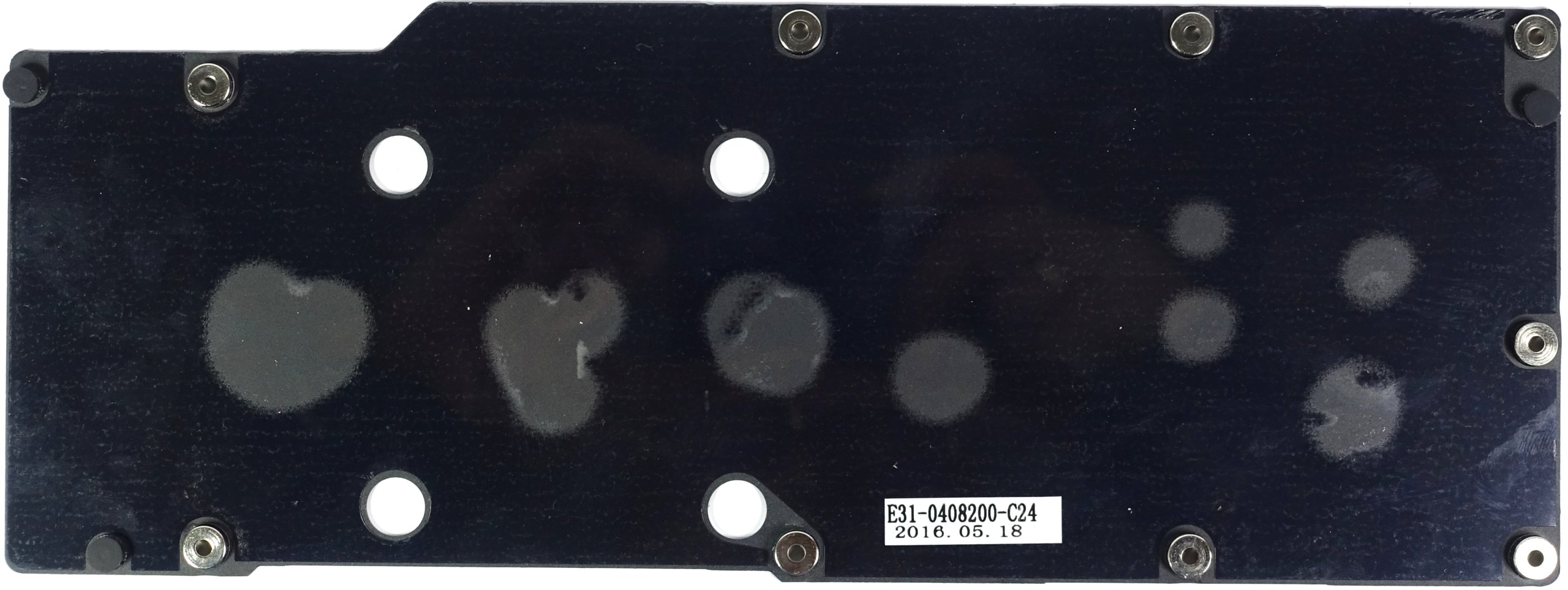Nvidia GeForce GTX 1080 Graphics Card Roundup
MSI GTX 1080 Sea Hawk
Why you can trust Tom's Hardware
Corsair convinced MSI to use its closed-loop liquid cooling solution on the GeForce GTX 1080, resulting in the GeForce GTX 1080 Sea Hawk. For the sake of simplicity, this card is based on Nvidia's reference design, but naturally includes much more effective cooling for the GPU.
Technical Specifications
MORE: Best Graphics Cards
MORE: Desktop GPU Performance Hierarchy Table
MORE: All Graphics Content
Exterior & Interfaces
The card's shroud is made of black plastic with a brushed aluminum-looking bit for eye candy. Weighing 44.2oz (1253grams), including the radiator and pipes, the Sea Hawk is obviously a lot heavier than an average GeForce GTX 1080. Yet it still puts much less of a burden on your motherboard than boards with oversized heat sinks. The other dimensions approximately match Nvidia's Founders Edition, as both products employ the same PCB.
It's also apparent that there's a hybrid cooling solution in play here. The Sea Hawk employs liquid cooling on the GPU, while the rest of the board utilizes conventional air cooling. A radial fan draws air in and exhausts it through the output bracket.


The back of the board is covered by a single-piece plate, which lacks openings for ventilation and is purely aesthetic. Plan for an additional one-fifth of an inch (5mm) in depth beyond the plate, which may become relevant in multi-GPU configurations. Of course, it's possible to use the card without a backplate. But removing it would risk voiding your warranty.
An eight-pin power connector sits toward the end of the board, tucked into the simple, subdued shroud. MSI's logo is back-lit, and the LED is controllable through bundled software.
A peek into the Sea Hawk's back end suggests that heat sink fins are positioned horizontally, guiding airflow to the output bracket. But those fins are fake; they have no measurable function.
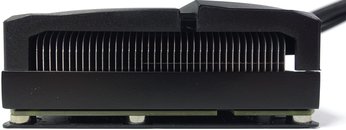

The rear bracket features five outputs, of which a maximum of four can be used simultaneously in a multi-monitor setup. In addition to one dual-link DVI-D connector (be aware that there is no analog signal), the bracket also exposes one HDMI 2.0b and three DisplayPort 1.4-ready outputs. Openings for airflow dot the rest of the bracket, but they don't actually serve their assumed purpose.
Board & Components
MSI's Sea Hawk employs Nvidia's reference design with its well-established pluses and minuses.
The 1080 Sea Hawk uses GDDR5X memory modules from Micron, which are sold along with Nvidia's GPU to board partners. Eight memory chips (MT58K256M32JA-100) transferring at 10 MT/s are attached to a 256-bit interface, allowing for a theoretical bandwidth of 320 GB/s.
A 5+1-phase configuration relies on the same uP9511P as Nvidia's Founders Edition card. It also uses a combination of matching N-channel MOSFETs, gate drivers, and Schottky diode. For its low- and high-sides, MSI taps a combination of two NTMFD4C85Ns. The mid-range coils are technically almost identical to Foxconn's magic coils.
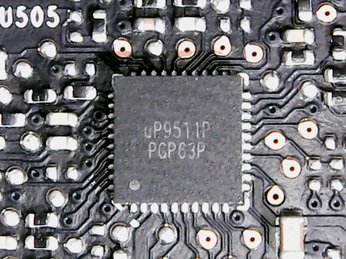

The memory gets its power through a separate phase that's controlled by the same undocumented chip used on Nvidia's reference board. It doesn't rely on the uP1728, which would have been almost the same (even pin-compatible). As we've seen from other cards already, current monitoring is enabled through the well-known INA3221.


In addition, two capacitors are installed right below the GPU to absorb and equalize peaks in voltage.
Power Results
Before we look at power consumption, we should talk about the correlation between GPU Boost frequency and core voltage, which are so similar that we decided to put their graphs one on top of the other. Mainly, the graphs don't change much thanks to an almost-constant GPU temperature. Our readings top out around 122°F (50°C). Thus, the Sea Hawk sustains the top of its GPU Boost range.
After warming up in a variable-load gaming scenario, GPU Boost fluctuates between 1936 MHz and 1875 MHz. As we'd expect from our stress test, the clock rate drops more significantly under constant load. The voltage measurements do look similar: while we see up to 1.05V in the beginning, that value later drops as low as 0.985V.
Summing up measured voltages and currents, we arrive at a total consumption figure we can easily confirm with our test equipment by monitoring the card's power connectors.
As a result of Nvidia's restrictions, manufacturers sacrifice the lowest possible frequency bin in order to gain an extra GPU Boost step. On the other hand, MSI's factory overclock is surprisingly moderate given its liquid cooler. As a result, the Sea Hawk can drop as low as 215 MHz. This doesn't affect power consumption at idle nearly as much as cards with frequency floors above 300 MHz.
| Power Consumption | |
|---|---|
| Idle | 11W |
| Idle Multi-Monitor | 13W |
| Blu-ray | 11W |
| Browser Games | 112-125W |
| Gaming (Metro Last Light at 4K) | 192W |
| Torture (FurMark) | 198W |
Now let's take a more detailed look at power consumption when the card is idle, when it's gaming at 4K, and during our stress test. The graphs show the distribution of load between each voltage and supply rail, providing a bird's eye view of variations and peaks:






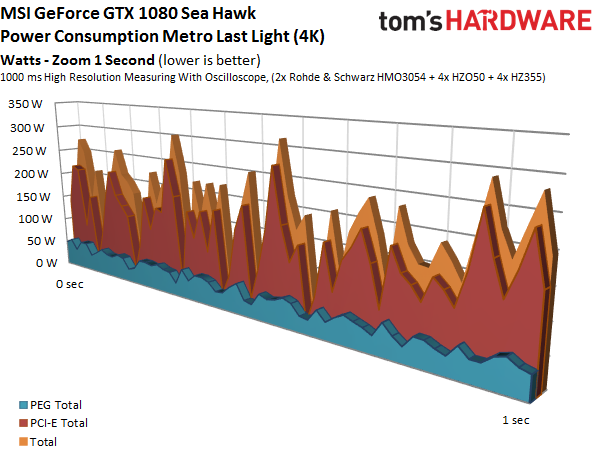




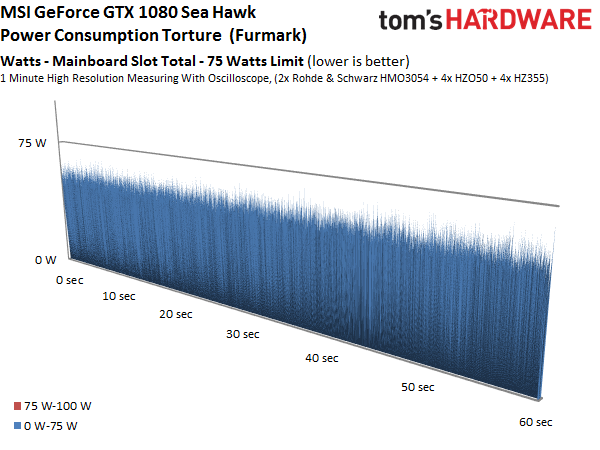
Temperature Results
Naturally, heat output is directly related to power consumption, and the 1080 Sea Hawk's ability to dissipate that thermal energy can only be understood by looking at its cooling solution. For starters, the backplate isn't much help. It is for visual purposes only, and doesn't even contribute to the card's structural integrity. Some thermal pads could have certainly made the plate more functional, but MSI missed that opportunity.
Corsair uses a massive frame to mount its pump above the GPU. Thanks to several thermal pads, this frame also cools components like the memory and MOSFETs. There's a recess in the frame just above the coils, but unfortunately that's not enough to let airflow reach the board's surface.
Looking at the frame from above, some kind of baffle is clearly covering the radial fan's back side. Air is consequently prevented from reaching that part of the card. Remember the fake fins we mentioned earlier? Without air moving through them, they serve very little purpose.
Even when MSI's card is idle, its fan spins at a minimum 33% duty cycle, or 1100 RPM. Apparently the fan curve was copied from Nvidia's Founders Edition without modification. That's pretty silly when you consider the liquid-cooled GPU rarely operates above 122°F (50°C).
It's also unfortunate that the radial fan is positioned right above the voltage regulators. There is no noticeable airflow right below the fan. Furthermore, the frame doesn't have any cooling fins that'd increase its surface area. Based on the simple issues we identified at a glance, this seems like an uninspired concept, which suffers from a lack of foresight.
As far as the pump is concerned, Corsair reached deep into Asetek's box of relics. This is a model we have known for years from all sorts of CPU- and GPU-cooling solutions. Its operating noise is clearly audible; there are much quieter and better pumps available these days, including options from Asetek.


Unfortunately the tubing is rather short. Installed in a larger case, hoses under 14 inches (35 centimeters) long start to get problematic if the radiator can't be mounted in place of a rear chassis fan.
The 4.75-inch (120mm) aluminum radiator features tightly-packed fins. Corsair's branded fan operates at a constant speed between 1100 to 1200 RPM, depending on the power connection, and can't be controlled by the graphics card. Coupled with the always-spinning radial fan, a certain amount of background noise is unavoidable, even when the card is idle.


The much-improved performance of this cooler compared to Nvidia's Founders Edition is reflected in our thermal readings.
A look at our infrared images shows that excess heat from the MOSFETs is partially dissipated by the GPU. With a bit more tuning, the memory and voltage regulation circuitry could have been made to run even cooler.
Our stress test reveals the flip side of MSI's hybrid design: the board temperatures are hardly better than they would have been on an air-cooled card. Given those results, a more tightly-integrated frame would have made a big difference.
Sound Results
Since the GPU temperatures during gaming and our stress test are similar, it's no surprise that the fan speed doesn't change much. The slight increase reflected by the blue line is an artifact of the Founders Edition profile requiring 1200 RPM for the temperature range. We're not sure why those settings weren't modified.
There is no semi-passive mode when Nvidia's GP104 is idle; the fan is constantly spinning. In the end, this results in a baseline noise level of roughly 36 dB(A) without load and for no real reason. Clearly this value is too high.
The 36.7 dB(A) we measured under full load is unacceptable for a liquid-cooled system. This value is the sum of all components: the pump, the radial fan, the 4.75in (12cm) radiator fan—none of which are quiet, which is a pity. With the Radeon Fury X's speed-controlled Nidec fan, AMD shows us that there's a quieter way to achieve liquid-cooling on an enthusiast graphics card. Even if Cooler Master initially screwed up that card's pump initially, the cooler as a whole was better-conceived.
In the end, MSI's GeForce GTX 1080 Sea Hawk cools its GPU well, but not its memory or voltage regulators. Moreover, it's a bit too loud. The cool GPU would have had quite a bit more overclocking potential, so that's wasted for no reason. We aren't even sure why MSI failed to load the reference PCB with all of the components it supports. After all, there's room for an additional power phase.
MSI GTX 1080 Sea Hawk
Reasons to buy
Reasons to avoid

MORE: Best Deals
MORE: Hot Bargains @PurchDeals
Current page: MSI GTX 1080 Sea Hawk
Prev Page MSI GTX 1080 Gaming X 8G Next Page Palit GTX 1080 GameRock Premium EditionGet Tom's Hardware's best news and in-depth reviews, straight to your inbox.

Igor Wallossek wrote a wide variety of hardware articles for Tom's Hardware, with a strong focus on technical analysis and in-depth reviews. His contributions have spanned a broad spectrum of PC components, including GPUs, CPUs, workstations, and PC builds. His insightful articles provide readers with detailed knowledge to make informed decisions in the ever-evolving tech landscape
-
ledhead11 Love the article!Reply
I'm really happy with my 2 xtreme's. Last month I cranked our A/C to 64f, closed all vents in the house except the one over my case and set the fans to 100%. I was able to game with the 2-2.1ghz speed all day at 4k. It was interesting to see the GPU usage drop a couple % while fps gained a few @ 4k and able to keep the temps below 60c.
After it was all said and done though, the noise wasn't really worth it. Stock settings are just barely louder than my case fans and I only lose 1-3fps @ 4k over that experience. Temps almost never go above 60c in a room around 70-74f. My mobo has the 3 spacing setup which I believe gives the cards a little more breathing room.
The zotac's were actually my first choice but gigabyte made it so easy on amazon and all the extra stuff was pretty cool.
I ended up recycling one of the sli bridges for my old 970's since my board needed the longer one from nvida. All in all a great value in my opinion.
One bad thing I forgot to mention and its in many customer reviews and videos and a fair amount of images-bent fins on a corner of the card. The foam packaging slightly bends one of the corners on the cards. You see it right when you open the box. Very easily fixed and happened on both of mine. To me, not a big deal, but again worth mentioning. -
redgarl The EVGA FTW is a piece of garbage! The video signal is dropping randomly and make my PC crash on Windows 10. Not only that, but my first card blow up after 40 days. I am on my second one and I am getting rid of it as soon as Vega is released. EVGA drop the ball hard time on this card. Their engineering design and quality assurance is as worst as Gigabyte. This card VRAM literally burn overtime. My only hope is waiting a year and RMA the damn thing so I can get another model. The only good thing is the customer support... they take care of you.Reply -
Nuckles_56 What I would have liked to have seen was a list of the maximum overclocks each card got for core and memory and the temperatures achieved by each coolerReply -
Hupiscratch It would be good if they get rid of the DVI connector. It blocks a lot of airflow on a card that's already critical on cooling. Almost nobody that's buying this card will use the DVI anyway.Reply -
Nuckles_56 Reply18984968 said:It would be good if they get rid of the DVI connector. It blocks a lot of airflow on a card that's already critical on cooling. Almost nobody that's buying this card will use the DVI anyway.
Two things here, most of the cards don't vent air out through the rear bracket anyway due to the direction of the cooling fins on the cards. Plus, there are going to be plenty of people out there who bought the cheap Korean 1440p monitors which only have DVI inputs on them who'll be using these cards -
ern88 I have the Gigabyte GTX 1080 G1 and I think it's a really good card. Can't go wrong with buying it.Reply -
The best card out of box is eVGA FTW. I am running two of them in SLI under Windows 7, and they run freaking cool. No heat issue whatsoever.Reply
-
Mike_297 I agree with 'THESILVERSKY'; Why no Asus cards? According to various reviews their Strixx line are some of the quietest cards going!Reply -
trinori LOL you didnt include the ASUS STRIX OC ?!?Reply
well you just voided the legitimacy of your own comparison/breakdown post didnt you...
"hey guys, here's a cool comparison of all the best 1080's by price and performance so that you can see which is the best card, except for some reason we didnt include arguably the best performing card available, have fun!"
lol please..







